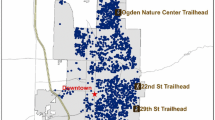Abstract
Recent studies of private streets have focussed on urban and suburban areas experiencing rapid growth; however, private road networks are also proliferating in some exurban and rural regions in areas of modest or slow growth. This study examines development on private roads in the commuter-shed of Halifax, Nova Scotia. On the basis of a detailed investigation of private roads conducted in 2006, we document how developers use private streets, describe the design features that result, and consider the socio-spatial implications private streets generate. The analysis reveals different ‘classes’ of private landscapes: from low end rural tracks with mobile homes or cars under repair in front yards, to high-end lakefront homes with expensive cars parked in the driveways. While private streets in the urban context facilitate sustainability goals like intensification and walkability, in the rural and exurban context private streets may reveal a second-class landscape where the affluent have good streets, the poor have potholes, and everyone has to drive everywhere.






Similar content being viewed by others
Notes
Researchers spent 6 days in the field, documenting and photographing conditions. We used three criteria for including a road in our analysis: first, it was not a government-owned road. Second, it must have a name, either on the municipal map or posted at the road entrance. Third the street needed more than one building; because we were interested in residential roads, at least one of the buildings had to be residential. As a result, we investigated 57 private roads in the HRM and 66 in East Hants. Because we respected any ‘No Trespassing’ signs we encountered, we could only observe the entrance conditions for some streets.
References
Barton, S.E. and Silverman, C.L. (1994) Public life and private property in the urban community, in Barton, S.E. and Silverman, C.J. (eds.) Common Interest Communities: Private Governments and the Public Interest. Berkeley: Institute of Governmental Studies Press, University of California.
Ben-Joseph, E. (1995) Residential street standards and neighbourhood traffic control: a survey of cities' practices and public officials' attitudes. WP 95-1, Institute of Transportation Studies, University of California, Berkeley.
Caldeira, T.P.R. (2001) Cities of Walls: Crime, Segregation and Citizenship in São Paulo. Berkeley: University of California Press.
Curran, A. (2005) Private streets and double standards: the Canadian planning response, Plan Canada, 45 (4): 42–45.
Curran, A. and Grant, J. (2006) Private streets: a survey of policy and practice, Canadian Journal of Urban Research: Canadian Planning and Policy, 15 (1): 62–78.
Duany, A., Plater-Zyberk, E. and Speck, J. (2000) Suburban Nation: The Rise of Sprawl and the Decline of the American Dream. New York: North Point Press.
East Hants Municipality. (2006) Street improvement by-law. No. 139a. http://www.easthants.ca/dev/bylaws/ (Accessed on 5 August 2006).
Ewing, R. (1996) Best Development Practices: Doing the Right Thing and Making Money at the Same Time. Chicago: APA Planners Press.
Girling, C. and Kellett, R. (2005) Skinny Streets and Green Neighborhoods: Design for Environment and Community. Washington: Island Press.
Grant, J. and Curran, A. (2007) Privatized suburbia: the implications of private roads, Environment and Planning B: Planning and Design, 34 (4): 740–754.
Grant, J., Greene, K. and Maxwell, K. (2004) The planning and policy implications of gated communities, Canadian Journal of Urban Research, 13 (1): 70–88.
Halifax Regional Municipality (HRM). (2002) Civic addressing by-law. C-300. http://www.halifax.ca/legislation/bylaws/hrm/documents/By-LawC-300.pdf (Accessed on 7 August 2006).
Handy, S., Paterson, R.G. and Butler, K. (2003) Planning for Street Connectivity: Getting from Here to There PAS Report #515. Chicago: American Planning Association.
Hester, R.T. (2006) Design for Ecological Democracy. Cambridge, MA: MIT Press.
Isin, E. and Tomalty, R. (1993) Resettling Cities: Canadian Residential Intensification Initiatives. Ottawa: Canada Mortgage and Housing Corporation.
Jacobs, A. (1993) Great Streets. Cambridge, MA: MIT Press.
Jacobs, A., Macdonald, E. and Rofe, Y. (2002) The Boulevard Book: History, Evolution, Design of Multiway Boulevards. Cambridge, MA: MIT Press.
Kohn, M. (2004) Brave New Neighborhoods: The Privatization of Public Space. New York: Routledge.
Lawrence, H.W. (1993) The greening of the squares of London: transformation of urban landscapes and ideals, Annals of the Association of American Geographers, 83 (1): 90–118.
Loomis, J. (2006) Privatizing Community: The Growth of Private Resident Associations. Calgary: Federation of Calgary Communities.
McKenzie, E. (1994) Privatopia: Homeowners Associations and the Rise of Residential Private Government. New Haven, CN: Yale University Press.
McKenzie, E. (2005) Planning through residential clubs: homeowners' associations, Economic Affairs, 25 (4): 28–31.
Moar, K. (2002) Frustrated homeowners demand city address private-road problems, The Daily News (Halifax) 9 December, p. 9.
Nelson, R.H. (2005) Private Neighborhoods and the Transformation of Local Government. Washington, DC: Urban Institute Press.
Sandalack, B. and Nicolai, A. (2002) Whatever happened to the public realm?, Plan Canada, 42 (2): 24–27.
Schmitz, A. and Bookout, l. (1998) Trends and Innovations in Master-Planned Communities. Washington: Urban Land Institute.
Southworth, M. and Ben-Joseph, E. (2003) Streets and the Shaping of Towns and Cities. Washington: Island Press.
Webster, C., Glasze, G. and Frantz, K. (2002) The global spread of gated communities, Environment and Planning B: Planning and Design, 29: 315–320.
Webster, C. and LeGoix, R. (2005) Planning by common hold, Economic Affairs, 25 (4): 19–23.
Acknowledgements
We are grateful to Stephanie Bohdanow and Jennifer Pritchard for their assistance during the field studies.
Author information
Authors and Affiliations
Corresponding author
Rights and permissions
About this article
Cite this article
Grant, J., Carson, L. Privatizing the fringe: patterns of private streets in a slow growth region. Urban Des Int 13, 253–262 (2008). https://doi.org/10.1057/udi.2008.28
Published:
Issue Date:
DOI: https://doi.org/10.1057/udi.2008.28




